Friday, 24 June 2016
FMP- Reflections
So, it's all over. We have had are end of year show and all are films have been shown. It's an odd feeling to say the least. When you have spent so much time on something, or somewhere, the idea that it will one day come to an end tends to fade from your mind the longer your there. The past year all led up to that Thursday night in the Komedia, and now it's over.
For me on a personal level the event was saying goodbye to a huge part of my life, that being education. You start school in this country at 5 years old and that is then your existence for 11 years at the very least. It's all you know. So stepping out of that environment and into a completely new one was a very strange feeling. You reflect on all you have done, achieved and learnt and hope it's enough to make your way through the turbulent sea which is the outside world, where your not protected by the strong harbour walls of schools, colleges, universities, teachers, tutors or parents.
However, I feel prepared to make that voyage. The training I have received, we have all received at college has given me confidence that I do have the needed skill set to make it through those troubled waters and that I will be able to make it to that island of success.
Okay, enough with the clever metaphors as I know how much you want me to just get join with it, so, lets get on with it. The end of year show I feel was a triumph. Both publishers and media students a like poured their heart and souls into their respective projects and it really showed. It was an amazing showcase of talent across the board and I was proud to be apart of it.
Myself and jakes film came out very well I feel, outside of one or two small tweaks that could have been made in the editing suite it was a well rounded narrative which seemed to grab and hold the attention of the audience. It was met with copies allpause and that for me shows that it was enjoyed.
Thank you class of 2016 for taking me under your wing and accepting me into your family. Without each of your kindness and friendship it would have been a significantly harder year than it was. Thank you to the tutors for putting up with my singing, dancing and generally loud nature, you will all be thoroughly missed.
Thursday, 19 May 2016
FMP- A Ladies Choice a Gentlemans Agreement
Odd title for this unit I know but let me explain. Due to the nature of how quickly pre-production happened, we never had written agreements with are actors. Well, not a contract at least. Instead we worked how many small filmmakers have to operate; handshakes, promises and emails. Now, this can be risky, especially when you are working with people you have no experience with. This is why I picked actors that I have worked with before and that I know are solid. Below you can see the emails I exchanged with each actor.
Jordan Danells (Mallory)
After are Skype call we arranged to meet in Bristol to talk through the character a little more and to do some read throughs. The meeting went really well and it was finished he would be playing the lead role of Mallory
Imogen Greenwood
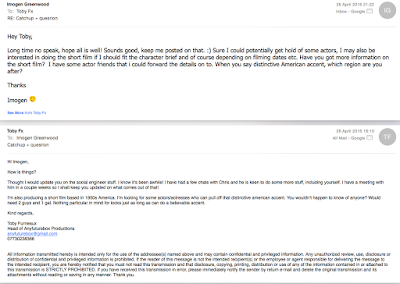
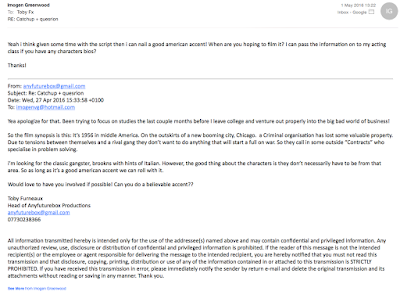
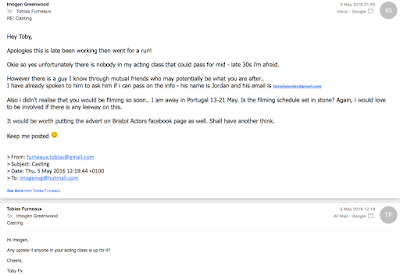
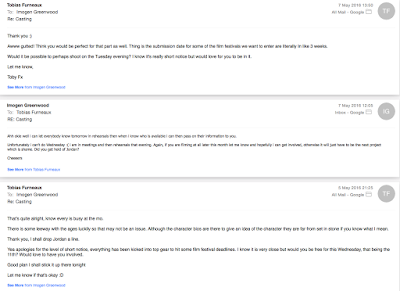 At first she as unavailable but, knowing that she would be perfect for the role, I decided to move the shoot around to accommodate her.
At first she as unavailable but, knowing that she would be perfect for the role, I decided to move the shoot around to accommodate her.
Ben Templar
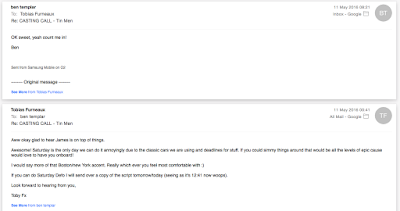
FMP- 99 problems
Filmmaking is all about problem solving. Making a film is, at the heart of it, a puzzle. So it's no surprise that during are FMP shoot we ran in to some issues. Here is what they were and how we dealt with them.
General Public
This tends to be an issue no matter where you go. However, when we decided on a location, a lay-by in the middle of no where, we were pretty confident that this wouldn't be to much of an issue. But alas, it was. Where we were filming is actually an entrance to a local cycle path. And as it turns out the UK has a lot more bike riders than we first thought. It became very clear very quickly that this would be a recurring issue.
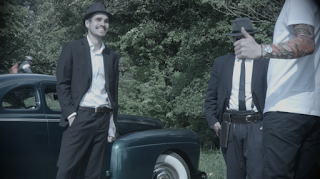 Although we had permission to shoot at the location from the council we did;'t have the ability to close it off to the public. So we simply had to wait between waves of people. If someone wondered behind a shot we paused then continued from the point before they got in the way. By the end we got this down to a fine art form.
Although we had permission to shoot at the location from the council we did;'t have the ability to close it off to the public. So we simply had to wait between waves of people. If someone wondered behind a shot we paused then continued from the point before they got in the way. By the end we got this down to a fine art form.
Continuity
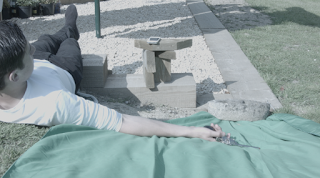 With so much going on in the film, some things were noticed to be quite off in the edit. The biggest example is that Mallory, after he shoots Mango, puts the gun used to kill his friend in his hand, making the whole thing look like a disagreement between two greasers. However, we didn't shoot his putting the gun in his hand meaning on all the wides he doesn't have a gun in his hand. This meant doing some last minute shooting at my house. Adding in a "putting gun in hand" shot and having to get Jake (who was the stand in actor for the day) to recreate the same arm position as on the day but on a green screen and holing the gun. We then keyed out the great and put the new arm on are head mango, fixing the otherwise tattered continuity.
With so much going on in the film, some things were noticed to be quite off in the edit. The biggest example is that Mallory, after he shoots Mango, puts the gun used to kill his friend in his hand, making the whole thing look like a disagreement between two greasers. However, we didn't shoot his putting the gun in his hand meaning on all the wides he doesn't have a gun in his hand. This meant doing some last minute shooting at my house. Adding in a "putting gun in hand" shot and having to get Jake (who was the stand in actor for the day) to recreate the same arm position as on the day but on a green screen and holing the gun. We then keyed out the great and put the new arm on are head mango, fixing the otherwise tattered continuity.
Traffic
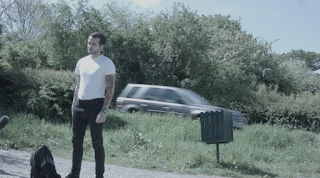 Another big challenge was the that the lay-by was right next to a road. Again, during recee's of the site it was evident that there wasn't that such through traffic, however, on the day there was significantly more. We went about dealing with this issue the same was we dealt with the public. Wait it out and then carry on once they pass.
Another big challenge was the that the lay-by was right next to a road. Again, during recee's of the site it was evident that there wasn't that such through traffic, however, on the day there was significantly more. We went about dealing with this issue the same was we dealt with the public. Wait it out and then carry on once they pass.
Actors Bailing
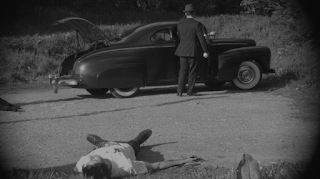 The day before we were meant to shoot, one of are actors had to leave the project due to person reasons. This left a huge hole to fill. Luckily, I had a few back-ups in mind for such a time. Unlikely, none were now avalblily, expect for Blake. The issue was he couldn't shoot on the Saturday, only the Sunday. This was the only time we had access to the car and main actors. So what we did was use a stand in on the Saturday. Jake dressed as Mango and did everything the character did, just off camera. The only time you can see him in briefly in the cig exchange scene and in some wides. All Blakes parts were shot the following day.
The day before we were meant to shoot, one of are actors had to leave the project due to person reasons. This left a huge hole to fill. Luckily, I had a few back-ups in mind for such a time. Unlikely, none were now avalblily, expect for Blake. The issue was he couldn't shoot on the Saturday, only the Sunday. This was the only time we had access to the car and main actors. So what we did was use a stand in on the Saturday. Jake dressed as Mango and did everything the character did, just off camera. The only time you can see him in briefly in the cig exchange scene and in some wides. All Blakes parts were shot the following day. FMP- Cranes, Cigarettes and Colour Correction
So, in my 3.1 - 3.2 (if you haven't read it it's on my blog) I outlined some different techniques I wanted to try during the production of my FMP. Those being; the use of a camera crane, the use of black and white and fake cigarettes. In this blog I'll be talking about how each aspect went and if I feel I have improved in some way on the subject.
Firstly we have the camera crane. Now although we did some tests with the job before shooting I was still sceptical where or not it would give the kind of shot I was looking for. However, we decided to use it anyway. We got some good advice from our lecturer Ed who told us to put more weight on the base to keep the crane steady, creating a smoother shot. Using the crane on set was a challenge. This was down to two reasons. Thaw first being that without any counterweights, you were really having to fight the Jib making operating it much more difficult. The second was that I couldn't see what we were shooting. My monitor decide to pack up on me so we were very much shooting blind.
All in all I like the shots. Although there is a significant amount of shake it blends in nicely with the era of film we were inspired by. Many shots in the film are much longer and more draw out then people are used to in modern Hollywood but that's due to the style and pacing of the genre.
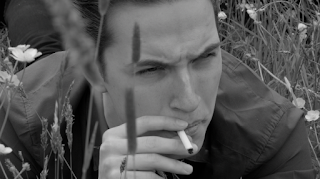 Second we have the use of black and white. I played around with many different ways to achieve the film noir look and settled on simply desaturaizing the image and then adjusting contrast, normally lowering the shadows making the image look more defined. Overall I think the images came out looking great! Every shot really plays to the genre and the black n white adds to it drastically. It adds that level of mysteriousness that was such an important part of film noir.
Second we have the use of black and white. I played around with many different ways to achieve the film noir look and settled on simply desaturaizing the image and then adjusting contrast, normally lowering the shadows making the image look more defined. Overall I think the images came out looking great! Every shot really plays to the genre and the black n white adds to it drastically. It adds that level of mysteriousness that was such an important part of film noir.
Third and finally is the fake cigs. Now we spent a lot of time on hand making them out of everything from tea to parsley but in the end we settled with real smokes. The actors were happy to use the real things so in the end we got a few packets and that was that. However, I feel like my research into that topic will help me in the future.
Tuesday, 17 May 2016
END OF YEAR SHOW- This Is The End
However, are work is far from done. We have an end of year show to plan! The only thing set in about the show is the venue, which is the Komedia in Bath. Other than that we have free range! First things first is looking at different types of live shows. After looking through some concepts we should be able to pin point what we want to go for.
A lot of what we want to do is governed, as always by the location. Lucky for us, the Komedia can accommodate most styles of events. From Rock gigs, to night raves, to cinema screenings to award shows and cooperate events it is very flexible.
Concept 1
My first concept is similar to shows such as the Emmy's and golden globes. This involved the show being presented by a single person (or pair) who guides the audience through the evenings happenings. This includes a variety of awards. Now normally these are for 'Best Film' or 'Best director", but instead we give out awards for more trivial things, such as 'Class clown', 'Best Laugh', Best distraction' etc.
Inter-weaved with the awards can be showings of are films, as well as purpose made skits, making fun of the students, lectures, the education system and everything in-between. One example would be a version of Ricky Gervais's office, based instead in are media department.
The layout of the venue would also take inspiration from the golden globes. That being tables arranged in-front of the stages with seating located behind them. This is also how the brit awards handles things. Students past and present sit around the tables with family and friends. While seating behind is allocated for general public.
Dress for students would be formal and we make a proper night out of it.
Concept 2
My second concept takes inspiration from the End of year show I attended last year. This consisted of a small introduction. Small snippets of the past 2 years work and then a playing of the two short films the students worked on for their FMPs. The evening was concluded by a video which consisted of each student saying what they enjoyed most about the course and what they would miss.
The set up was very simply. The upper balcony was used for seating while the lower level I believe was unused. Although simply, it was very effective. Overall the presentation was over quite quickly, only lasting about 30 - 40 minutes. A nice little touch was small cards on each seat which were small versions of the two main films posters.
Opinion cornor
Personal I prefer concept 1 much more than 2. It is slightly different with some nice twists on well known tropes. It makes each student really feel the gravitates about what the show means, the end of college life. I also feel like there is more that can be done with the idea. Plus, from an outsider point of view there will be a lot of laughs to keep people entertained. Of course this idea does involve a lot more work but I feel that it is worth it for are last hoorah.
END OF YEAR SHOW - Getting people through the doors
For our end of year show spectacular we have chosen to hold it at the Komedia in the center of Bath. The venue boasts a large variety of different set-ups accommodation everything from large standing gigs, cabaret seating and classic rowed seats. So when it comes to our show, we have quite a choice on are hands.
However, whatever set-up we eventually pick there is one thing that doesn't change. The fact that we will need people to fill the space. This isn't simply a case of wanting to get the most for our money. The event is acting as a way for us to showcase all the the hard work and effort we have put in over the past 2 years.
The show is also a chance for the friends and family of the class to come and see our work displayed on the big screen. However, the show can also act as a bit of a networking event. By inviting local production company's to the showing we can start to build contacts in the industry, helping those who want to get a foot in the door in such a competitive business.
We can go about this by contacting companies directly, both through emails and over the phone. Better yet, if we met with representatives before the show, for example over a coffee, we can build a relationship with them increasing the likelihood of them attending.
As well as industry professionals we also want members of the general public to attend. One way we could go about this is by utilizing our connections at the Bath Chronicle. Getting something on their website, or better yet in the paper, will plant it in the public eye and get some much needed press.
Something that we can glean from last year is inviting officials from the bath area. An example is that of the mayor of Bath who attend last year. This again will help build hype for the show.
Thursday, 5 May 2016
FMP- Close Encounter of the Film Kind
So lets first look at the style of how we want the film to do. That being, black and white. There are many different ways to achieve this look. However, something to look at is how things look in that style. Set dressing is all different when it's not in colour. Also, making sure we shoot in a format that is easy to tamper with in post will be key.
Another important part of the film will be the camera movement. We want to achieve a 1950s look, not just in the set dressing or props or script, but in the production style. Many aspects of filmmaking which are now common, and that have been perfected, were still in there development stages during the 50s. Getting that slightly imperfect look will be important to selling the overall project.
Although the film is in no way a SCI-FI VFX packed explosion fest, there will be some smaller effects. The importance of nailing these effects is huge. A shody effect can and will pull a viewer away from the story.
Monday, 25 April 2016
FMP- Camera Cranes and Where to Find Them
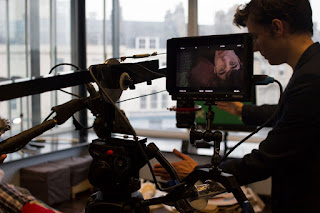 There is no one piece of equipment that will make a film amazing, nor make a great filmmaker. Instead, we use each but of equipment and method like puzzle pieces. On there own they are little use to anyone, but when brought together, they form the bigger picture. Adding weapons to your arsenal strengths and broadens your ability. Something that I have wanted to add to my personal armoury for a while is that of jib/crane shots.
There is no one piece of equipment that will make a film amazing, nor make a great filmmaker. Instead, we use each but of equipment and method like puzzle pieces. On there own they are little use to anyone, but when brought together, they form the bigger picture. Adding weapons to your arsenal strengths and broadens your ability. Something that I have wanted to add to my personal armoury for a while is that of jib/crane shots.This technic was pioneered in Hollywood during the nearly 1940s before homed in by late 1960s. It involves mounting a camera onto an apparatus which can drastically add height to a shot. Specially made equipment was soon produced, but was only available to big studios as they cost a small fortune. However, as time went on and filmmaking gear became more readily available, the price dropped significantly.
The purpose of a Jib is to had a vertical movement to the camera. This could be to get a high angle of a new location and then to dip into the action as the camera goes down to street level. It also has a native production value about it. The average viewer will associate a jib shot with larger productions, meaning it can make something with a small (or no) budget seem a lot larger scale.
Examples of Jib shots can be seen in almost every Hollywood film for the last 60 years. Famous examples include the opening scene in Touch of Evil (Orson Welles. 1958), High noon (Fred Zinnermann. 1952), Breaking News (Johnnie To. 2004) and The Stunt Man (Richard Rush. 1980). As you can see, the technic spands all genres and has a verity of uses.
I have a small experience with Jibs. On our last short film "Scribes" we used what is know as a pocket Jib to great effect. This is simply a smaller version of a larger Job. This was to achieve a birds eye view of are lead laying on the sofa. The birds eye shot is one that I am particularly keen on.
We have done some short tests with a larger Jib, the footage I shall include in my 3.1 - 3.2 vlog.
Friday, 15 April 2016
FMP- Puffing on Hot Air
Lets talk about cigarettes. Particularly cigarettes in film. Since the beginning of Hollywood, actors and actresses have been seen puffing away on tobacco. From pipes to smoking sticks to cigars these have formed a key part of film history. In fact movie stars were often sponsored by tobacco companies to smoke their product in front of the camera and behind the scenes. Hell some of the most famous pictures in cinema are of stars smoking. For example Audrey Hepburn in every single promotional piece for the two time Oscar winning film "Breakfast at Tiffany's".
However, there is something that has always puzzled me about this smoking Hollywood culture. And that is "What are they really smoking". No, I don't mean are they puffing away of illegal substances (although I am sure when stars do behind closed doors) rather is what you see on screen real or fake? For example what If you have an actor who doesn't smoke or an actress who was given up the habit and doesn't what to relapse?
Well for a long time it was industry standard to simply use real tobacco! In fact Clint Eastwood famously hated smoking, however for almost all his classic western roles he had to puff on a cigar, giving him that tough guy look. However, the taste of the slow burning, unfiltered tobacco often made him feel very ill, sometimes causing him to gag between takes.
After it started to come out that smoking wasn't fantastic for your health, the industry realised that having an actor smoke 50 or more cigarettes a day wasn't doing great things for their health. This is also around the point where some celebs were trying to kick the habit. So in the place of tobacco cigarettes they began using herbal ones. These are free from both tobacco and nicotine.
From a look point of view the two are Identical and would be impossible to tell apart both on and off screen. The TV show Mad men uses them on a regular bases for actors who don't smoke tobacco. John Hamm, in particular, was quoted as saying that he smoked 74 herbal cigarettes during the shooting of the pilot of Mad Men.
Following the genre of noir and the general attitude of 1950s America, all the characters in my film smoke. If they do not smoke tobacco we will either have to get herbal cigarettes, or come up with an alternative. For example, there are many only tutorials for making fake cigarettes for films. One example is using parsley to replace the tobacco. Tastes a little strange and burns faster than your average cigarette but looks the part. I will be trying a few methods to create the smoking look, I will either share my results in a follow up blogpost or in some kind of video format.
Tuesday, 12 April 2016
FMP- Reaching out
Being a filmmaker is all about expanding your skill set. Now there are many ways to do this, you can watch the masters of cinema and learn from them, read a book on certain technics or even be told how to do something by a much more experience filmmaker. All these things are good, but don't surpass the knowledge you gain from actually picking up a camera and doing it yourself, old fashioned trial and error.
As a budding filmmaker, there are many styles and techniques I am yet to use, that is why my FMP offers such a great opportunity to learn. I have also decided on a project which will require skills to produce a style I have never really tried to achieve, film noir. It is such a distractive style that there are countless things that I am going to need to research into and practise.
The first big one is lighting. In any production lighting is a corner stone, shoots are often planned to be in certain times of the day so they get the right light. With such a unique style as noir, you have to be very specific in how you light your scene. This is something that will require a ton of practise, both in the studio and in an outside environment.
The next thing to look at is black and white as well as selective colour. There are many ways to achieve a black and white look. Most cameras now allow you to shoot native in BnW in camera and sucking the colour out of a video is as easy as pulling down a slider in post. However, when shooting for back and white there are certain things that need to be addressed. It will be these issues and differences that I will need to research into to get the most organic feeling film.
Something which is less technical but still a key part of the film will be how can we get actors smoking cigarettes if they are either non-smokers or recovering from addiction. The last thing we want is someone who was previously addicted to start up again because of the film, that is a lawsuit waiting to happen. However, the noir genre demands smoke so one way or another we will get it. I want to find out what they use in Hollywood and experiment with perhaps doing something in post.
The big finally thing that I want to improve on is the camera movement. The genre of film noir has some signature angles and movements that I would love to be able to recreate. This will take time and effort but should really add to the overall project.
Monday, 4 April 2016
FMP- Baby steps into Production
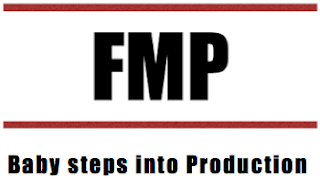
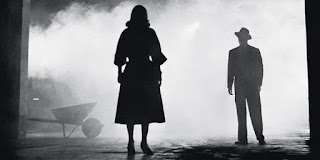 So, all the research is done and the theory is complete. So now what? Well, it's time to see how what I have learned will effect my film and then how I intend to processed tentatively into production. So first lets look at the obvious one. I want my film to fall into the noir/neo-noir genre. So what am I going to have to do to get the desired genre? Well, a main thing will be nailing the lighting. The genre has such Iconic lighting that getting it wrong simply isn't an option. Also, the tone of the film has to be dark, dripping in drama and intriuge like all good noir should. It was also clear from my research that certain camera angles are often used in noir. One personal favorite is the low-angle. This is used to make a character look larger than he or she is to make them seem more powerful or intimidating. This is used all the time in classic noir, making heroes more heroic and villains more villainous.
So, all the research is done and the theory is complete. So now what? Well, it's time to see how what I have learned will effect my film and then how I intend to processed tentatively into production. So first lets look at the obvious one. I want my film to fall into the noir/neo-noir genre. So what am I going to have to do to get the desired genre? Well, a main thing will be nailing the lighting. The genre has such Iconic lighting that getting it wrong simply isn't an option. Also, the tone of the film has to be dark, dripping in drama and intriuge like all good noir should. It was also clear from my research that certain camera angles are often used in noir. One personal favorite is the low-angle. This is used to make a character look larger than he or she is to make them seem more powerful or intimidating. This is used all the time in classic noir, making heroes more heroic and villains more villainous. So that's style covered, but what about props? From my primary research, it's obvious that getting things that fit the 1950s time frame will be really important. Everything from costumes to cars to sets need to throw you back 60 years. It should be obivious that we are in the past just from the props, sets and clothing. I want to try and avoid the whole text on screen telling the the year thing.
Regrading characters, from looking at real life examples they need to be brutal and ruthless. They need to play with peoples lives like they are just pawns on a chessboard. Cause after all, that's how they few them, means to an need. As the film takes place just after WW2, people are hardened to death as it became just part of life.
With everything taken into consideration I know exactly what I need to do to continue this project. First will be completing the script, making sure we capture that era and also the brutal nature of the criminal world. Next will be doing camera and lighting tests to really nail down that iconic look. Finally we will be sorted props (clothes, cars etc) that fit into are 1950s time frame, as well as doing casting and location scouting.
FMP- Research conclusions
Drawing conclusions from research is key to getting the most out of what you have been looking into. It's from your conclusion that you know the next steps to take and it's no different for me. As part of my unit 13 I have been looking into things to help further the development of my idea, a short Noir gangster film based in 1950s America. I wanted to get an idea, not just of the history of gang culture, but also the history of the film Noir genre. I also wanted to see what people thought of when it came to building a belivable 1950s America.
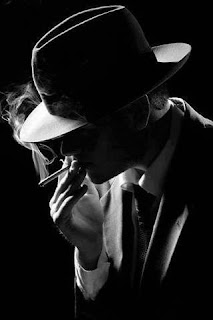 So what did I learn. Well, firstly lets look at gangsters. I looked into the history of gangster ism in America, focusing on events happening after the 1900s. This included prohibition and the world wars. For my research it is very clear that these men were brutal in there quest for power. One example that I highlighted was the Valentines day massacre where six mob associates and a
mechanic of the North Side Irish gang led by Bugs Moran were put up against and wall and shot. This highlighted for the cut throat nature of the shady underbelly that was the criminal underworld of 1900 America.
So what did I learn. Well, firstly lets look at gangsters. I looked into the history of gangster ism in America, focusing on events happening after the 1900s. This included prohibition and the world wars. For my research it is very clear that these men were brutal in there quest for power. One example that I highlighted was the Valentines day massacre where six mob associates and a
mechanic of the North Side Irish gang led by Bugs Moran were put up against and wall and shot. This highlighted for the cut throat nature of the shady underbelly that was the criminal underworld of 1900 America. The next thing I looked into was the Noir film genre. What I learnt from looking into this part of film history was really the key elements that were needed for a film to qualify to be Noir. It needs to be dark with every shot oozing of shade and the night. Also, there are some set conventions for how people in the film should look. For example, men should be suit wearing, clean cut, trilby toting manly men who smoke 3 packets a day. Finally, films focus on more dark themes, those being murder, sex and drugs.
The most interesting part of my research came from my primary questionnaire. This is where I asked people what they thought was key into creating a real feeling 1950s environment. Unsurprisingly, it was clear that all 3 elements, those being vehicles, sets and clothing are key in making the feel we want.
So, all things considered, it is clear now how to proceed, but that will all be highlighted in my next blog post.
Friday, 1 April 2016
FMP- Secondary Research
Along side my primary research I also conducted some secondary. I went about this by using the internet to dive a little deeper into not just the noir genre, but also gang culture in 1950s america and how these two elements can come together to help my FMP.
Film Noir
First things first, what is film noir? "A French term meaning "black film," or film of the night, inspired by classic crime novels" (Ebert R. 1995). The genre was the one of the first to make the audience know that the story was most likely to not have a happy ending. Sets and environments were all designed to "...reek of the night, of shadows, of alleys, of the back doors of fancy places, of apartment buildings with a high turnover rate, of taxi drivers and bartenders who have seen it all." (Ebert R. 1995)
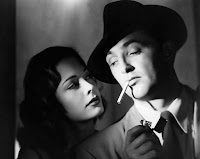 There is a lot of tropes which come with the noir genre. One of the biggest has to be
There is a lot of tropes which come with the noir genre. One of the biggest has to be cigarettes. "Everybody in film noir is always smoking, as if to say, 'On top of everything else, I've been assigned to get through three packs today.' The best smoking movie of all time is "Out of the Past," in which Robert Mitchum and Kirk Douglas smoke furiously at each other. At one point Mitchum enters a room, Douglas extends a pack and says, "Cigarette?" and Mitchum, holding up this hand, says, "Smoking."."
Noir also has a very strict dress code:
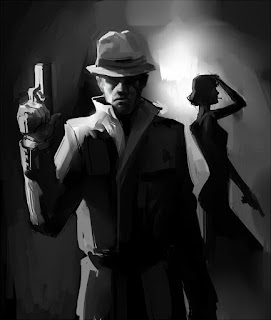 "For women: low necklines, floppy hats, mascara, lipstick, dressing rooms, boudoirs, calling the doorman by his first name, high heels, red dresses, elbowlength gloves, mixing drinks, having gangsters as boyfriends, having soft spots for alcoholic private eyes, wanting a lot of someone else's women, sprawling dead on the floor with every limb meticulously arranged and every hair in place.
"For women: low necklines, floppy hats, mascara, lipstick, dressing rooms, boudoirs, calling the doorman by his first name, high heels, red dresses, elbowlength gloves, mixing drinks, having gangsters as boyfriends, having soft spots for alcoholic private eyes, wanting a lot of someone else's women, sprawling dead on the floor with every limb meticulously arranged and every hair in place."For men: fedoras, suits and ties, shabby residential hotels with a neon sign blinking through the window, buying yourself a drink out of the office bottle, cars with running boards, all-night diners, protecting kids who shouldn't be playing with the big guys, being on first-name terms with homicide cops, knowing a lot of people whose descriptions end in "ies," such as bookies, newsies, junkies, alkys, jockeys and cabbies." (Ebert R. 1995)
The final key puzzle pieces to the Film noir were "women who would just as soon kill you as love you, and vice versa". Movies are also shot in black and white or made to look like they are. A film that includes some colour is normally moved into the neo-noir.
1950s American Crime Culture
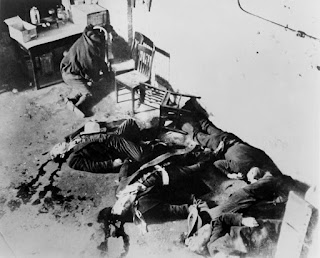 Although organised crime has always been present in the western world, it wasn't till the early 1900s when prohibition swept the united states that crime groups starting making a lot of money, and therefor grew into crime empires. They would smuggle alcohol over the boarder from Mexico and sell it in under ground clubs and "speak-easies". By the time prohibition was lifted, crime organisations were worth more than more big business, meaning they had all the money and resources they needed.
Although organised crime has always been present in the western world, it wasn't till the early 1900s when prohibition swept the united states that crime groups starting making a lot of money, and therefor grew into crime empires. They would smuggle alcohol over the boarder from Mexico and sell it in under ground clubs and "speak-easies". By the time prohibition was lifted, crime organisations were worth more than more big business, meaning they had all the money and resources they needed.Then came the second world war. The young men that returned from the violence were trained killing machines, with no problem with doing dirty jobs. This gave crime empires a lot of fresh meat. This membership surge meant that criminals now had small armies at there disposal. In turn, violence between rival gangs grew with events like the Valentine day massacres highlighting the brutal nature of the this shady under belly.
Thursday, 31 March 2016
FMP- Primary research
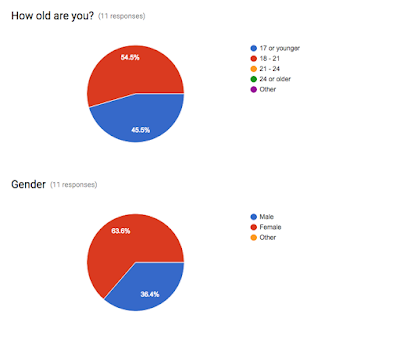 As part of my FMP I was tasked with conducting some primary research into my idea. I wanted to see what people thought of the noir style, how they would build a believable 1950s environment and how other films similar to mine achieved the look and feel that I want to mimic. To do this I utilised to methods, the first was creating a survey and putting it out online. In the questionnaire I asked for the age and gender of the participant to gauge what different demographics wanted. These were my results:
As part of my FMP I was tasked with conducting some primary research into my idea. I wanted to see what people thought of the noir style, how they would build a believable 1950s environment and how other films similar to mine achieved the look and feel that I want to mimic. To do this I utilised to methods, the first was creating a survey and putting it out online. In the questionnaire I asked for the age and gender of the participant to gauge what different demographics wanted. These were my results: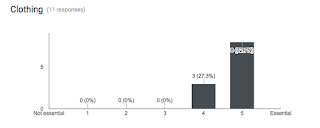
 As you can see, the survey was mainly done by 18 to 21 year olds with the gender predominately being female. Next I asked them to rank a number of elements in levels of importance in creating a 1950's feel. The most important from are surveyors was clothing, with 72.7% of people putting it the essential need of the spectrum. However, all 3 choices (Clothing, Vehicles and locations) received at least 5 essential votes, showing how important all 3 elements are in creating a living breathing 50s world. The only one that got a 1 in importance was Locations.
As you can see, the survey was mainly done by 18 to 21 year olds with the gender predominately being female. Next I asked them to rank a number of elements in levels of importance in creating a 1950's feel. The most important from are surveyors was clothing, with 72.7% of people putting it the essential need of the spectrum. However, all 3 choices (Clothing, Vehicles and locations) received at least 5 essential votes, showing how important all 3 elements are in creating a living breathing 50s world. The only one that got a 1 in importance was Locations. 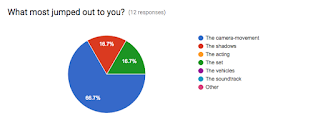 The final part of the survey came from watching the opening to "A touch of Evil" by Orson Welles as then answering which part of the scene caught the viewers attention most. It was clear that one element stood out above the rest. That being camera movement. The other two that share the remaining 33.4% are shadows and the set. Getting those 3 elements will be important in getting right during production.
The final part of the survey came from watching the opening to "A touch of Evil" by Orson Welles as then answering which part of the scene caught the viewers attention most. It was clear that one element stood out above the rest. That being camera movement. The other two that share the remaining 33.4% are shadows and the set. Getting those 3 elements will be important in getting right during production.The next part of my Primary research came from watching the aforementioned film, A touch of Evil. The classic film is famed for not only being a cinematic masterpiece but also it as hailed as the last proper noir film from the golden age of cinema. The film is directed by Orson Welles and stars Charlson Heston, Janet Leigh and Orson Welles in the crime drama. The story follows an investigation into a car bombing on the american side of the Mexico Boarder.
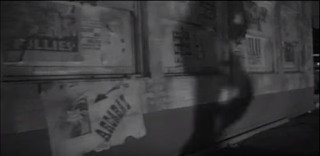
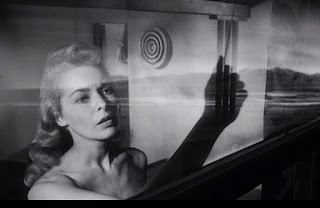 What I learned for watching the film was just how affectively you can use shadows and reflections to tell a story. For example, at the very beginning of the film we see a mysterious stranger plant a bomb in a mans car. As he runs towards the Vehicle, he casts a shadow on a large wall. This shot really hammers home that this is a shady characters whos identity will remain a secret and the only way to learn that secret is to watch the film. The use of reflections was also fascinating. It was obvious that mirrors and windows were placed and used strategically to add an extra dynamic to a scene.
What I learned for watching the film was just how affectively you can use shadows and reflections to tell a story. For example, at the very beginning of the film we see a mysterious stranger plant a bomb in a mans car. As he runs towards the Vehicle, he casts a shadow on a large wall. This shot really hammers home that this is a shady characters whos identity will remain a secret and the only way to learn that secret is to watch the film. The use of reflections was also fascinating. It was obvious that mirrors and windows were placed and used strategically to add an extra dynamic to a scene.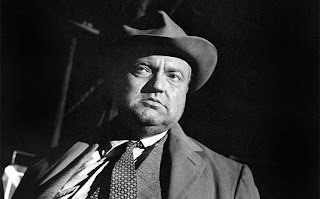
A good example of this technic is when Janet Leighs character opens the blinds of her motel to look out over the desert. Instead of it being a shot over her shoulder showing the view and the a reverse of her reaction, we get best of both worlds by the use of reflections. This adds a depth to the scene and visual intrigue that otherwise wouldn't exist.
Another shot type used throughout the film is the low angle shot. Now Orson Welles is famous for using low shots, even digging a hole in the studio to get the camera lower during filming of Citizen Kane. They are used predominately to show a character as powerful and he uses it with mastery. Take the opening shot where Orson Welles character, Hank is introduced. He is meant to be an intimidating man, and therefor having the camera low emphasises that idea.
Thursday, 17 March 2016
FMP- Compare and Contrast
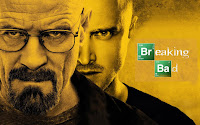 To best explain a new idea or concept, its normally best to compare it to a preexisting property or IP. This means people can get an idea of what your product is and it's use. The same goes for the Media industry. When selling an idea to an executive, comparing your show/movie to something that already exists (and thats more importantly is successful) gives them an idea of the genre and audience you going for.
To best explain a new idea or concept, its normally best to compare it to a preexisting property or IP. This means people can get an idea of what your product is and it's use. The same goes for the Media industry. When selling an idea to an executive, comparing your show/movie to something that already exists (and thats more importantly is successful) gives them an idea of the genre and audience you going for.So it seems like a good idea to get a few examples which are similar, or you can at least compare against, my film. The first property that comes to mind has to be Breaking bad. As I want the short to be apart of Tv pitch, it seems fit to start with a TV show. Breaking bad encompasses a lot of what I want to replicate. From the non-chronological order to it's look and tone, the show oozes that old school noir vibe. It does this through it's character development and unique shot types. It also has a very distinctive look with an orange tint which always accompanies desert scenes. It also follows the idea that anyone can die, and will die, when you least expect it. Similarly, we want to build that same sense that no one is safe.
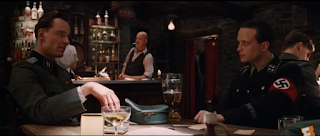 Another film which could compare to are film is Quentin Tarantinos World war 2 masterpiece, Inglourious Basterds. In particular a certain scene in a small bar where the main characters stand-off against a SS officer who figures out they aren't what they seem. The suspense that Tarantino builds using just a few simply shots is amazing. You really feel the weight of the situation slowly weighing down on you as the scene progresses. This is the kind of feeling I want to replicate in our film. That feeling like everything is building to an inevitable crescendo.
Another film which could compare to are film is Quentin Tarantinos World war 2 masterpiece, Inglourious Basterds. In particular a certain scene in a small bar where the main characters stand-off against a SS officer who figures out they aren't what they seem. The suspense that Tarantino builds using just a few simply shots is amazing. You really feel the weight of the situation slowly weighing down on you as the scene progresses. This is the kind of feeling I want to replicate in our film. That feeling like everything is building to an inevitable crescendo.The final example of what I want the film to be like is my favourite film of all time. The Coan Brothers masterclass in filmmaking, which is of course No Country for Old Men". Everything about the film is perfect from it's cinematography to spot on dialogue, it nails it. What I want to glean most for it however is it's tone. That feeling of we have just entered into a shady part of the world, one we do not understand and where normal rules don't apply. Another thing to learn from NCFOM is building up a good bady. Someone who isn't silly or over the top, but creepy and scary. The final thing that the Coans have gifted me is there use of colours. I love the grade on all of their films but No country is one of the best. Every image looks like a painting and that is down simply to angle, lighting and colouring,
FMP- Proposal analysis
To start of any project, you must first write a proposal. A Statement of intent if you will, on where you are planning to go and how your going to get there. This includes the idea itself, why you chose the idea, the skills you will need to achieve your desired end product and how you will assess your success at the end of it all. A proposal is a useful tool for reflection as you can compare your end product with your beginning idea, learning what had to be changed and what challenges you faced. You can then use this knowledge in future projects to better assess a production.
Looking back at my UNIT 12 research, I think my proposal is a good one. I looked into how ideas go from mind to paper to screen and a recurring theme I saw was that of using short screen tests or films to sell a bigger idea. This is exactly what my idea is and from my proposal it makes that clear. One clear strength is the kit we will be using. Giving the short a very cinematic feel will be important to selling the look of the film, as well as solidifying us as professional filmmakers in the eyes of an executive. Also, having the unique style we want for the short will help to make it stand out from the sea of wannabe TV show pilots.
Taking into consider my primary and secondary research, I believe that the proposal best reflects what I want to achieve and how I can achieve it. Granted, things will change and challenges will arise, but for now, it is a pretty tight proposal. To conclude the analysis I have produced a Strengths and weaknesses of the proposal:
Thursday, 25 February 2016
IMP Directors Chronicle- Role evaluation and progression
So, all the blood sweat and tears have finally paid off. The sleepless nights and hectic days have all lead to a good end product. As a crew we worked together really well with each department puling it's weight in he uphill battle which is film making. But now is a time to reflect back on my own role as Director. In this post I hope to answer the important questions like what were the strengths & challenges and how did I overcome. Plus how I can progress in the industry in my chosen job role.
First things first likes start out with are best foot forward, Strengths. I felt that I was a very effective director when it came to putting my ideas and concepts across. As Quentin Tarantino says "being a good director isn't about being able to be good at everything to bring your vision to life, it's about explaining your vision to people that know what they are doing". I took that advice very much to heart during the production. Instead of having to think about multiply things at once (like I normally have to do when working) I instead honed on just on my role, focusing on working with the actors to get the best performances.
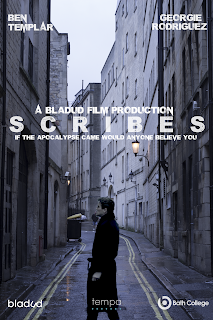 This wasn't easy at times as in the past I have struggled with putting the ideas in my brain into actual words that make sense but, with some practise (and some patients from my amazing crew) we managed it. My crew mates seem to agree as well which is great after the stressfulness of working so closely on a project like Scribes.
This wasn't easy at times as in the past I have struggled with putting the ideas in my brain into actual words that make sense but, with some practise (and some patients from my amazing crew) we managed it. My crew mates seem to agree as well which is great after the stressfulness of working so closely on a project like Scribes. Another strength that I felt really help things along was coordination. Right from the beginning, I knew that if I wasn't organised that I would be totally overwhelmed by the task. Me and my DOP started work as early as we could on getting some test footage and storyboardings out the feel and style we wanted. Same goes with myself and the Producer during the casting process. I wanted to get the ball rolling on things as soon as possible so no to have things jump up at us when deadlines started getting tight.
My final Strength was working with the actors. As previously mentioned, I was able to really spend some time with them on set, helping them to understand their role and what I needed from them. This lead to two very good and believable performances. You can really feel that brother and sister relationship on screen, as well as Dans distress when his world starts to come crashing down around him.
However, you can't have strengths without some weaknesses. For me, my biggest weakness was my own lateness. Time keeping has always been an issue for me and this project was no different. If their is one thing I could do different from a role stand point it would be to have got everywhere an hour earlier than I did.
Unsurprisingly, with a project of this size their were a lot of challenges. One of the biggest issues we had came the night before are many studio shoot. We had purpose built a flat in a studio space but only had it for one day. However, in try film making style, one on the key cables for connection up the camera to an external monitor broke. This meant we wouldn't be able to use the camera crane the next day meaning we wouldn't have been able get a lot of the shots we needed. Nightmare! We walked around bath for hours searching high and low for a new cable but alas, nothing. That night I reserved one at a local electronics store. Then, that morning, I waited outside for them to open to be the first in to get the cable.
Overall, I have learnt a huge amount as a film maker and even more as a director. I will take away from this project the true need for team work and clear communication as well as being able to clearly put your vision into words or a media that others can understand.
Subscribe to:
Comments (Atom)






















